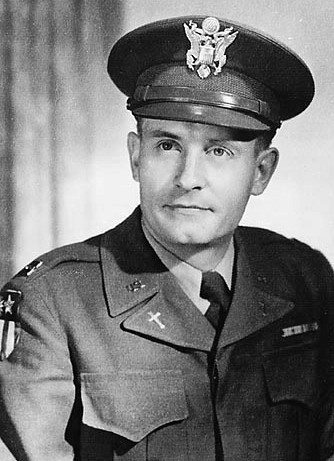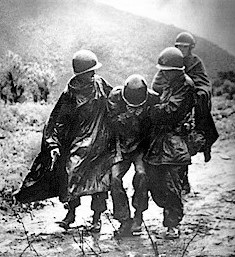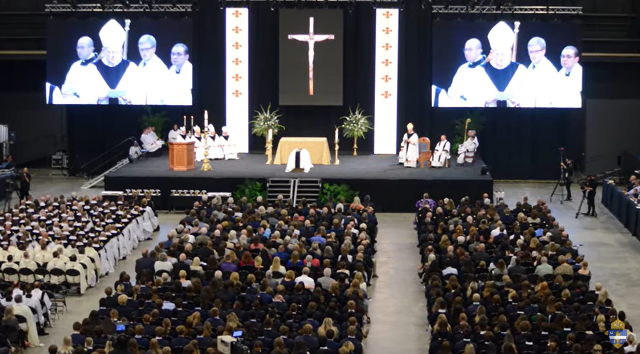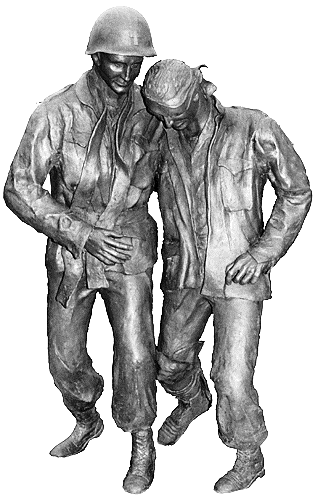
 |
 |
Man of God, U.S. Army Captain, Prisoner of War, Saint. All describe Emil Joseph Kapaun. Although the latter is not official (there is an effort underway to make it so), to the men who had the good fortune to be in his presence, there is no doubt.
Chaplain Kapaun first served his god and country in battle in the China-Burma-India (CBI) Theaterduring World War II. Arriving in India in April of 1945, he ministered to soldiers along the Ledo Road from Ledo, India to Lashio, Burma.
While in the CBI Theater, Father Kapaun befriended T/4 Howard Sherman of the 25th Field Hospital. Sherman assisted Father Kapaun during Mass at the Hopital's mess hall.
"I had been helping Father Edward Glavin, Catholic Chaplain of the Mars Task Force, serve Mass when he was in our area. He introduced me to Father Kapaun and we struck up a great friendship. When Father Glavin received orders to move out with the Marauders, Father Kapaun asked me to continue assistingat Mass.
"After the Mars Task Force liberated Lashio, we traveled to two Missions in the area. We met a priest and nuns from Italy who had established Missions in Lashio and Namtu, Burma. Not only did Father Kapaun minister to our troops, he also helped the local Missions in many ways.
 T/4 Howard Sherman with Italian Missionary Father Mongesi. T/4 Howard Sherman with Italian Missionary Father Mongesi. |
"I continued to assist Father Kapaun when he was in our area. He had a territory of over 2,000 miles to cover from Ledo to Lashio and did so mainly by Jeep. He enjoyed his beer and pipe. When we received our rations, we shared them with him, and there were times when he brought his rations toshare with me and my buddies."
Father Kapaun continued to serve in CBI until May 1946, long after most Americans had been rotated home. Released from active duty in July of 1946, he returned home and went to college under the G.I. Bill. He earned his Master of Arts Degree in Education in February of 1948.
"I continued to hear from him after the war, while he attended the Catholic University in Washington, D.C." relates Sherman. "He was planning to visit me at my home in Johnstown, Pennsylvania, when I last corresponded with him. Because of his recall to his home area, he was unable to make the trip. I next heard from him after he decided to go back to the Army Chaplain's School. He wrote me from Fort Bliss, El Paso, Texas, telling me of his decision and his desire to serve the troops once more, during the Korean War. Shortly after Christmas 1949 I received a card from him telling me he was on his way to Japan."
 Children of the Missionary School (background) at Lashio, Burma. |
 Christmas Card sent by Father Kapaun to Howard Sherman. |
Having volunteered to go back on active duty, Father Kapaun was assigned to the 1st Cavalry Division in Japan, and was soon serving in Korea as 3rd Battalion Chaplain.
During the height of a fierce battle at Unsan, North Korea on November 2, 1950, in which his Regiment faced overwhelming Chinese Communist forces, Father Kapaun was taken prisoner. Reports received noted that Father Kapaun s feet had become badly frozen, but that he continued to administer to the sick and wounded. He continuously went out under heavy mortar and shelling to carry or pull into holes wounded and or dying soldiers at personal risk of being captured or killed. Refusing to leave the wounded when given the opportunity to get out of the Unsan perimeter, he stayed with Capt. C. L. Anderson, M.D., ministering to the wounded and dying.
 |
During his imprisonment, Father Kapaun served as an inspiration to his fellow soldiers. While on an over 100-mile march to the prison camp location, a Communist guard threatened to shoot a faltering soldier. Father Kapaun pushed the guard aside, risking his own life, got the faltering man to his feet and helped him continue the march. This act is now immortalized in a bronze statue which stands in the father's home town of Pilsen, Kansas.
Many accounts were given as to the many comforts he provided the men of the 8th Cavalry Regiment during imprisonment. They were both spiritual and physical. He provided endless hours of prayer and encouragement. He stole food from his captors in order to keep his fellow prisoners from starving to death.
"In his soiled and ragged fatigues, with his scraggly beard and his queer woolen cap, made of the sleeve of an old GI sweater, pulled down over his ears, he looked like any other half-starved prisoner. But there was something in his voice and bearing that was different with dignity, a composure, a serenity that radiated from him like a light. Wherever he stood was holy ground, and the spirit within him a spirit of reverence and abiding faith went out to the silent listening men and gave them hope and courage and a sense of peace."
Seven months of captivity, abuse by his captors, respiratory disease and a blood clot in his leg,caused a serious decline in his health. Still, he continued tending to his flock up until he could no longer do so. Confined to a filthy Communist prison "death house," his captors refused to allow proper medical care, including an operation by Doctor Anderson to amputate his leg, which probably would have saved his life.
Chaplain Emil J. Kapaun died on May 23, 1951 in Pyoktong, North Korea. His remains were buried in an unmarked grave along the Yalu River.
Father Kapaun was awarded the Distinguished Service Cross, Legion of Merit and the Bronze Star Medal with "V" device for valor.
Emil J. Kapaun: more than just a man, more than just a soldier, even more than a Chaplain. A Saint.
 Father Kapaun (right) with Sgt. Loungan of Battalion Headquarters, along the Ledo Road in Burma. |
 Mother Mary Columba and Sister Mary Lena at the Mission in Lashio that Father Kapaun worked to support. |
Father Kapaun inspired others... Dear Mrs. Sherman, with all good wishes & promises of prayers from The MOTHER SUPERIOR & Sisters toward whomSgt. Sherman is so kind & good. CONVENT OF OUR LADY OF THE SACRED HEART. NAMTU N.S.S. Namtu 29/7/45 Dear Mrs. Sherman, with all good wishes & promises of prayers from The MOTHER SUPERIOR & Sisters toward whomSgt. Sherman is so kind & good. CONVENT OF OUR LADY OF THE SACRED HEART. NAMTU N.S.S. Namtu 29/7/45 |
CLICK LETTER TO ENLARGE
|
Excerpts from a pamphlet written by 1st Lt. Ray M. (Mike) Dowe, Jr. He wore the cross of the Chaplain branch instead of the crossed rifles of the infantry, but he was, I think, the best foot soldier I ever knew, and the kindest. His name was Emil Joseph Kapaun, and he was a priest of the Roman Catholic Church. The men he served in the prison camps of Korea didn't care whether he was Catholic or Baptist, Lutheran or Presbyterian. To all of them, Catholic, Protestant and Jew alike, and to men who professed no formal faith at all, he was simply "FATHER," and each of them, when in trouble came, drew courage and hope and strength from him. He's dead now, murdered by the Red Chinese, and his body lies in an unmarked grave somewhere along the Yalu. The hundreds of men who knew and loved him have not forgotten him. I write this so folks at home can know what kind of a man he was, and what he did for us, and how he died. The first thing I want to make clear is this, he was a priest of the Church, and a man of great piety, but there was nothing ethereal about him, nothing soft or unctious or holier than thou. He wore his piety in his heart. Outwardly he was all G.I., tough of body, rough of speech sometimes, full of the wry humor of the combat soldier. In a camp where men had to steal or starve, he was the most accomplished food thief of them all. In a prison whose inmates hated their communist captors with a bone deep hate, he was the most unbending enemy of Communism, and when they tried to brainwash him, he had the guts to tell them to their faces that they lied. He pitied the Reds for their delusions, but he preached no doctrine of turn-the-other-cheek. I came upon him once sitting in the sunshine by the road. There was a smile on his face and a look of happiness in his eyes. I hated to break in on his meditations, but I needed cheering, so I asked him, "What are you thinking of, Father?" "Of that happy day," he said, "when the first American tank rolls down the road, then I'm going to catch that little so and so, Comrade Sun, and kick his butt right over the compound fence." Father always spoke in parallels, relating the sufferings that Christ endured to those we were forced to bear. As he spoke, the agony in the garden, the road to Calvary, the Crucifixion, became very real to us who bore our own crosses of blows, and cold, and illness, and starvation. Christ endured, he told us, and we, too, must endure, for the day of our resurrection from the tomb of the prison camp would surely come, as surely as the stone was rolled away from the sepulchre. It is because of these sermons, which gave hope and courage, and food he stole for us, and the care he gave us when we were sick, many of us came back home who never would have survived our long ordeal without him. |
RESOLUTION of the United States Federation of Korea Veterans Organizations (USFKVO) WHEREAS Father Emil J. Kapaun, Chaplain, US Army, a native of Pilsen, Kansas, and accredited by the Diocese of Wichita, United States of America, was Chaplain of the 8th Cavalry Regiment, 1st Cavalry Division, Korea, in 1950, and WHEREAS Chaplain Kapaun distinguished himself, as both a Soldier and a Chaplain, on the field of battle in Korea during the early days of the Korean War in an uncommon manner, ministering both spiritually and physically to his fellow Soldiers, particularly the sick, wounded and dying, becoming a legend among the troops he served, and WHEREAS Chaplain Kapaun further distinguished himself by ministering to the wounded and dying of his Regiment, during the height of the fierce battle at Unsan, North Korea on November 2, 1950, in which his Regiment faced overwhelming odds because of the Chinese Communist invasion of Korea, a battle from which Chaplain Kapaun might have escaped but remained behind ministering to the wounded and dying, as provided in the Geneva Conventions, a decision resulting in his capture by the Chinese Communist Command, and WHEREAS Chaplain Kapaun, illegally designated a Prisoner of War rather than a detained person, as provided for in the Geneva Conventions, while a prisoner of war in several camps in the vicinity of PYOKTONG, NORTH KOREA, unselfishly gave himself in total service to his fellow Prisoners of War, his military duty and his commitment as an instrument of God, without regard to race, color, or creed, performing EXCEEDINGLY ABOVE AND BEYOND THE CALL OF DUTY to provide aid and comfort to his fellow Prisoners of War urging their will to live and will to continue to be American and Free World fighting men even in captivity, all at the cost of his own health and well-being as evidenced by numerous documented acts of the most conspicuous gallantry and intrepidity, in the presence of an armed enemy, and WHEREAS Chaplain Kapaun died on May 23, 1951, of abuse by his captors, respiratory disease and a blood clot in his leg, confined to a filthy Communist prison "death house" tending to his flock up until he could do so no longer, his sacrifice an example to inspire and encourage his companions and others held as Prisoners of War throughout the camps as they received word of his indomitable courage and spirit for God and Country, and WHEREAS Chaplain Kapaun through the example of his life and military duty has become one of the most popular heroes of the Korean War, Soldier and Saint, an inspiration to his fellow prisoners, and all who serve in the military, who gave of himself until he was spent, often referred to as the man who best sums up the glory of the Chaplain Corps, and WHEREAS Chaplain Kapaun was universally known as a soldier's soldier and a saint by those who served with him during his military service, and especially by those who suffered with him in the brutal Communist prison camps, and WHEREAS the life and heroic exploits of Chaplain Kapaun are widely know throughout the Chaplain Corps and the Korean War Veteran Community and to numbers of the public in the US and other nations of the world, and WHEREAS the Vatican, in 1993, in testimony of the love and affection of those who knew him and of his extraordinary love of and devotion to his fellow man, announced that Emil J. Kapaun was to be named a "Servant of God," the first step to an eventual elevation to sainthood in the Roman Catholic Church, and WHEREAS the United States Federation of Korea Veterans Organizations (USFKVO), Inc., notes and supports the efforts among the five million American Korea War and Korea service veterans community, and the resolutions of the Korean War Veterans Association, USA (KWVA) and many other American institutions seeking the appropriate posthumous award of the Medal of Honor to Chaplain Emil J. Kapaun, US Army; so, THEREFORE BE IT RESOLVED that the United States Federation of Korea Veterans Organizations (USFKVO), Inc., supports the recommendation for posthumous award of THE MEDAL OF HONOR to Chaplain Emil J. Kapaun, one of the US Army's and United Nations Command s finest, and we encourage the Senior US Army Decorations Board to favorably act on this resolution and all other petitions to this end; and, BE IT FURTHER RESOLVED that the United States Federation of Korea Veterans Organizations (USFKVO), Inc., calls upon the International Federation of Korean War Veterans Associations, Seoul, Korea, and all veterans groups in the free world to support this resolution. April 24, 2004 |
2021 Update: Fr. Kapaun Comes HomeOn March 4, 2021, the U.S. Defense POW/MIA Accounting Agency (DPAA), an agency of the Department of Defense, notified Ray Kapaun, Fr. Kapaun s nephew, that the hero s remains had been positively identified among other Korean War soldiers buried at the National Memorial Cemetery of the Pacific in Hawaii. President Rob Knapp 82 said finding out about Fr. Kapaun s remains being identified was unbelievable.
On Sept. 21, Fr. Kapaun's remains were returned to the Kapaun family in a ceremony in Pearl Harbor, Hawaii. Fr. Kapaun's family, along with representatives from the Diocese of Wichita, including Bishop Carl Kemme were in attendance. His remains began the journey home on Sept. 24, 2021, the day the coincided with Kapaun Mt. Carmel's Homecoming, making the high school events extra special. It s a really exciting time right now because I think everyone here has the mentality that we re bringing the old Kapaun back, said senior Isaac Schmitz, football player and Homecoming candidate, in a Sept. 25 Varsity Kansas article. And for that to happen the same time when we re bringing Fr. Kapaun home is just amazing. He s been lost for so long and he died for everyone else in that prisoner of war camp. The fact that he is our hero, our namesake and he s coming home and it coincides with the year we re doing great in football is just amazing. The football team wore special black uniforms featuring the POW-MIA "You are Not Forgotten" symbol, specially sanctioned for the game. The Homecoming king and queen were also announced via a pre-recorded message from Ray Kapaun, Fr. Kapaun's nephew and family spokesperson. "The military escort stays with the remains along the way [from Hawaii], which is the military's way to honor those who have fallen and ensure their security," said Scott Carter, the coordinator for the Father Kapaun Guild, in a Sept. 17 article in the Catholic Advance. "They are never left along; they are loved and not forgotten." Fr. Kapaun's first stop upon returning to Kansas was to St. John Nepomucene in Pilsen, his home parish. The tiny town of just 40 residents an hour northeast of Wichita, hosted a parade and Mass for their fallen hero, who after 70 years had finally returned home. From there, the native son, the hope of the diocese, the Servant of God, made his way to the Cathedral of the Immaculate Conception in Wichita for a vespers service for the priests of the diocese on Sept. 27. A luncheon will be held the following day for special guests, including families of the prisoners of war and military officials. A public vigil will be held in the evening at Hartman Arena Sept. 28. Sandwiched between those two events, Kapaun Mt. Carmel will be offering Fr. Kapaun Tours to showcase the school's Fr. Kapaun's military and personal effects on display to those in town for the funeral events. Fr. Kapaun's funeral will also be held at Hartman Arena, on Wednesday, Sept. 29. Kapaun Mt. Carmel has secured tickets for its senior class and faculty members interested in attending, and has canceled school to allow for greatest participation in the events. EWTN is also scheduled to broadcast both Hartmen events. After the funeral, Fr. Kapaun's casket will be placed in a horse-drawn military caisson for a procession to the Cathedral. The procession will begin near Veterans' Memorial Park on Central Avenue and continue about a half-mile to the Cathedral. His remains will be housed in a 5,400-pound marble tomb in the east transept of the Cathedral until further notice. This public venue will allow for visitors, but also offer security for the remains of the Medal of Honor recipient. |


IN MEMORIAM |